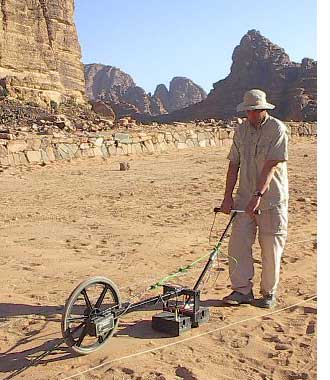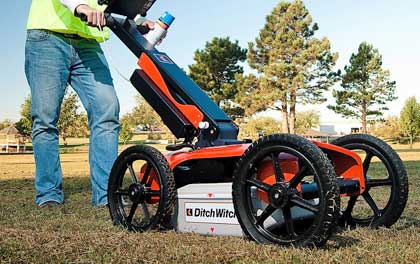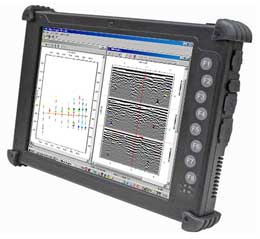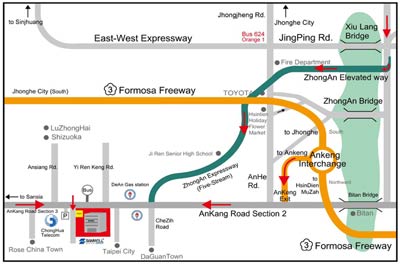|
|
Rugged tablets in ground penetrating radar (GPR) surveys
Compact, versatile ruggedized COTS tablet computers add functionality to GPR systems while adding customization potential and reducing total cost of ownership.
In this article, we'll present a brief introduction to ground penetrating radar (GPR), and the advantages of using standard commercial off-the-shelf (COTS) rugged tablet computers with GPR systems. We will also present a tablet computer solution from the Samwell Group's line of RUGGEDBOOK mobile computers.
Radar is generally used to discover the presence, position, speed and direction of objects in the air or on the sea via very high frequency radio waves. Radar, however, can also be used to survey the ground, to see what is beneath the surface. This type of radar is called ground penetrating radar, or GPR, and it is being used in a large variety of ways.
 What's needed to conduct ground penetrating radar? The answer requires a basic description of GPR. Unlike above ground radar where electromagnetic waves are generally transmitted by rotating the emitter around a fixed axis, ground penetrating radar relies on moving the transmitter over the surface. The wave then travels into the ground where objects of different properties are reflecting the waves back to a receiver antenna, and from there to a computer that analyzes the data and displays it in a variety of ways. GPR applications include: What's needed to conduct ground penetrating radar? The answer requires a basic description of GPR. Unlike above ground radar where electromagnetic waves are generally transmitted by rotating the emitter around a fixed axis, ground penetrating radar relies on moving the transmitter over the surface. The wave then travels into the ground where objects of different properties are reflecting the waves back to a receiver antenna, and from there to a computer that analyzes the data and displays it in a variety of ways. GPR applications include:
Analysis of soil, ground water, ice and bedrock
Testing of underground building materials
Non-destructing testing of subterranean conditions
Locating underground structure and infrastructure (such as pipes, foundations, etc.)
Archeological research
Military applications
Environmental testing and monitoring
 Ground penetrating radar systems come in a variety of sizes, shapes and forms. Small units can be carried whereas larger ones may look like lawnmower-like pushcarts or are mounted on vehicles. One thing that almost all ground penetrating radar systems have in common is the presence of an electronics unit and a display, often some sort of ruggedized tablet computer. Ground penetrating radar systems come in a variety of sizes, shapes and forms. Small units can be carried whereas larger ones may look like lawnmower-like pushcarts or are mounted on vehicles. One thing that almost all ground penetrating radar systems have in common is the presence of an electronics unit and a display, often some sort of ruggedized tablet computer.
With recent advances in tablet computing technology, using generic COTS systems has become increasingly attractive as such systems offer superior flexibility, versatility and processing power at a lower cost. And unlike dedicated units, commercial tablet computers can easily be upgraded and customized both on the hardware and software side. In addition, COTS tablets generally include the wireless communications technology to quickly share results in client-server setups or move data back and forth between multiple systems.
Since ground penetrating radar units are used outdoors, and often in environmentally adverse conditions, tablet computers used in GPR systems must be able to reliably function under such operating conditions. This includes a wide operating temperature range; the ability to handle shock, vibration, dust and rain; and the ability to be used with gloves on. In addition, the display must be viewable in bright sunlight without glare or distracting reflections. Additional requirements are:

- The tablet must be compact and light enough to be mountable almost anywhere, and also be detached and used as a mobile system or in an office.
- While most smartphones and consumer tablets now have capacitive touch screens, those are not usable in the rain and with gloves on. Resistive works better for GPR, and the display must be large, bright, and sharp enough to clearly see GPR text and image data.
- The device must include, or be available with, all major mobile computing communications methods (i.e. WiFi, GPS, WWLAN, Bluetooth, etc.) to reliably facilitate positioning, instant communication, lookups, data capture and data capture/tracking.
- Offer reliable, accurate GPS functionality to quickly and precisely determine position and interact with software and peripherals.
- Be built to withstand vibration, drops, temperature extremes as well as dust and water and other environmental conditions as outlined in MIL-STD-810G and other testing procedures.
 An example of a rugged tablet computer that fills all of those requirements is the Samwell RUGGEDBOOK Rugged Tablet PC-750 tablet computer shown to the right. The device has a 10.4-inch daylight-readable resistive touch display that is large enough to show a wealth of information (including detailed GPR image data), but is still light and compact enough to mount on a variety of GPR system. IP54 sealing means the unit is protected against dust, rain and weather, and the device has passed the requisite environmental tests for this sort of deployment. An example of a rugged tablet computer that fills all of those requirements is the Samwell RUGGEDBOOK Rugged Tablet PC-750 tablet computer shown to the right. The device has a 10.4-inch daylight-readable resistive touch display that is large enough to show a wealth of information (including detailed GPR image data), but is still light and compact enough to mount on a variety of GPR system. IP54 sealing means the unit is protected against dust, rain and weather, and the device has passed the requisite environmental tests for this sort of deployment.
The Samwell RUGGEDBOOK PC-750 offers Windows functionality and performance in a rugged tablet form factor. Measuring just 10.8 x 7.8 x 1.1 inches and weighing under three pounds, the PC-750 is lighter and handier than full-size rugged tablets without requiring compromises. The tablet has excellent wired connectivity on board (4 x USB 2.0, RS232, RJ45, audio, etc.), the connectors are standard size, and there is a wealth of wireless functionality (including available GPS and 3.75G radio) and also dual integrated cameras. The device can easily be carried and just as easily mounted on various types of GPR systems.
Relevant Information:
— Samwell Group RUGGEDBOOK Rugged Tablet PC-750 page
— GPR case study (Taiwan)
— GPR in archeology (Taiwan National Science Council)
To learn more about the ruggedized Samwell PC-750 tablet computer and its many applications, email RUGGEDBOOK at info at ruggedbook.com.tw. And check RuggedPCReview.com's description of the Rugged Tablet PC-750.
RUGGEDBOOK Headquarters
Samwell Building
317-1, Sec. 2,
AnKang Rd., Xindian Dist.
New Taipei City 23153, Taiwan (R.O.C.)
Telephone: 886-2-2214-1133
Fax: 886-2-2215-5458
Web: www.ruggedbook.com.tw
info@ruggedbook.com.tw
|





 What's needed to conduct ground penetrating radar? The answer requires a basic description of GPR. Unlike above ground radar where electromagnetic waves are generally transmitted by rotating the emitter around a fixed axis, ground penetrating radar relies on moving the transmitter over the surface. The wave then travels into the ground where objects of different properties are reflecting the waves back to a receiver antenna, and from there to a computer that analyzes the data and displays it in a variety of ways. GPR applications include:
What's needed to conduct ground penetrating radar? The answer requires a basic description of GPR. Unlike above ground radar where electromagnetic waves are generally transmitted by rotating the emitter around a fixed axis, ground penetrating radar relies on moving the transmitter over the surface. The wave then travels into the ground where objects of different properties are reflecting the waves back to a receiver antenna, and from there to a computer that analyzes the data and displays it in a variety of ways. GPR applications include:
 Ground penetrating radar systems come in a variety of sizes, shapes and forms. Small units can be carried whereas larger ones may look like lawnmower-like pushcarts or are mounted on vehicles. One thing that almost all ground penetrating radar systems have in common is the presence of an electronics unit and a display, often some sort of ruggedized tablet computer.
Ground penetrating radar systems come in a variety of sizes, shapes and forms. Small units can be carried whereas larger ones may look like lawnmower-like pushcarts or are mounted on vehicles. One thing that almost all ground penetrating radar systems have in common is the presence of an electronics unit and a display, often some sort of ruggedized tablet computer.

 An example of a rugged tablet computer that fills all of those requirements is the Samwell RUGGEDBOOK Rugged Tablet PC-750 tablet computer shown to the right. The device has a 10.4-inch daylight-readable resistive touch display that is large enough to show a wealth of information (including detailed GPR image data), but is still light and compact enough to mount on a variety of GPR system. IP54 sealing means the unit is protected against dust, rain and weather, and the device has passed the requisite environmental tests for this sort of deployment.
An example of a rugged tablet computer that fills all of those requirements is the Samwell RUGGEDBOOK Rugged Tablet PC-750 tablet computer shown to the right. The device has a 10.4-inch daylight-readable resistive touch display that is large enough to show a wealth of information (including detailed GPR image data), but is still light and compact enough to mount on a variety of GPR system. IP54 sealing means the unit is protected against dust, rain and weather, and the device has passed the requisite environmental tests for this sort of deployment.
